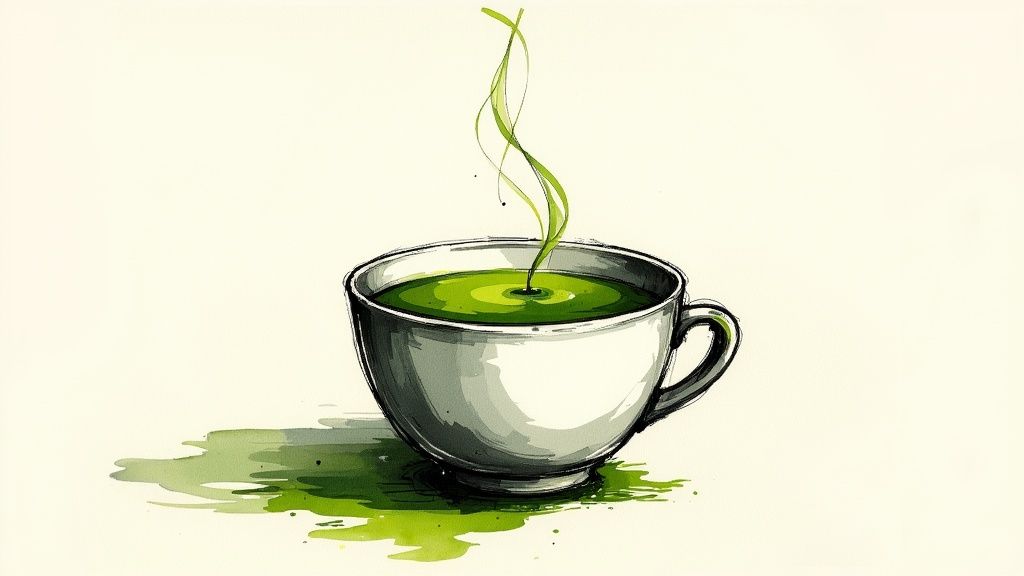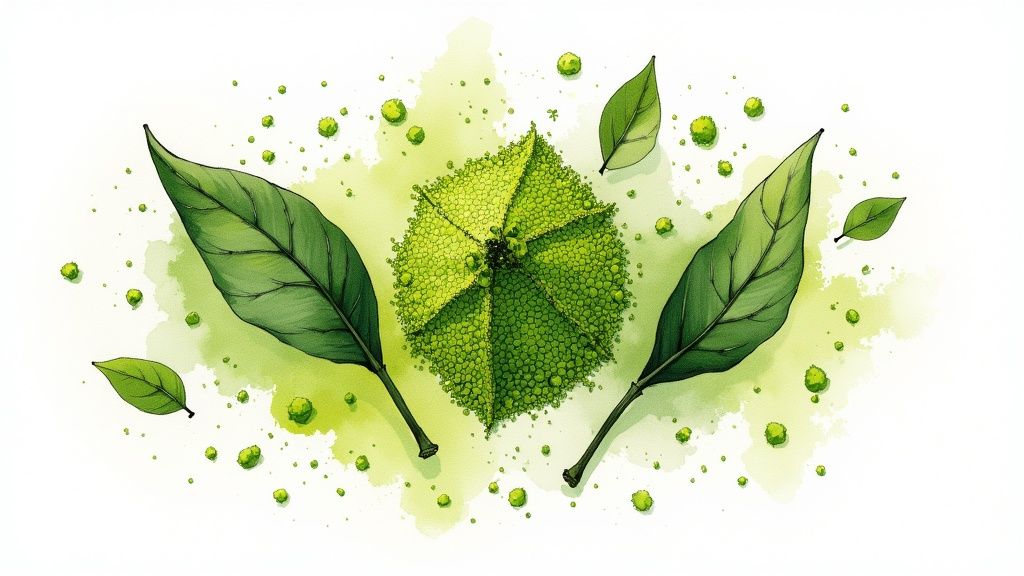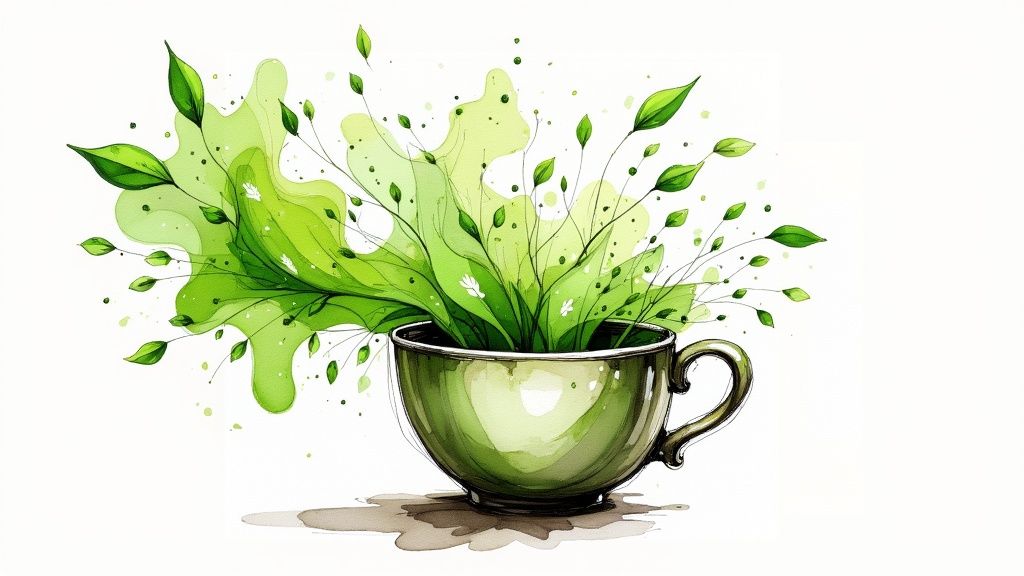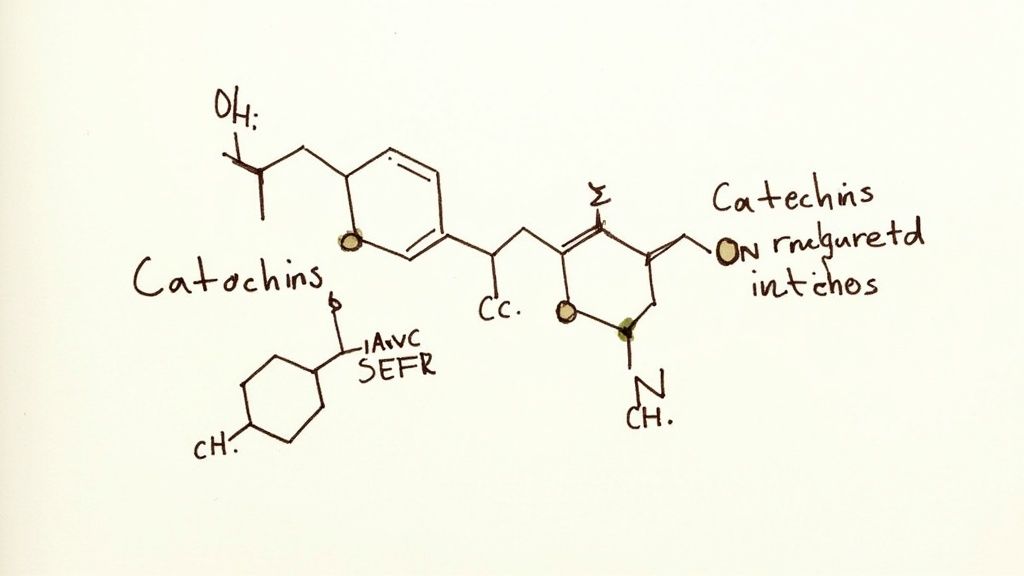The Remarkable Science Behind Matcha's Antioxidant Power

The striking green color of matcha isn't just for show – it signals the presence of powerful compounds that make this tea a standout among health-promoting beverages. Let's explore the fascinating science that explains why matcha packs such an antioxidant punch compared to other teas.
The EGCG Advantage: A Catechin Powerhouse
At the heart of matcha's health benefits is epigallocatechin gallate (EGCG), a type of catechin that acts as a potent antioxidant. Regular green tea contains EGCG too, but matcha delivers up to 137 times more. This dramatic difference comes from the unique way matcha is grown – farmers shield the tea plants from direct sunlight for 20-30 days before harvest. This careful shading process triggers the plants to produce more chlorophyll and amino acids, naturally concentrating EGCG and other beneficial compounds. The result? A bright green powder with exceptional antioxidant content.
Combating Oxidative Stress: The Cellular Shield
EGCG's importance lies in its role as a free radical fighter. These unstable molecules can damage our cells and lead to oxidative stress, which is linked to many chronic health issues like heart disease, cancer and brain disorders. By consuming matcha regularly, you give your body a steady supply of EGCG to help neutralize these harmful compounds. Think of it as equipping your cells with protective armor against daily environmental damage.
Whole-Leaf Consumption: Maximizing Bioavailability
Unlike regular green tea where you discard the leaves after steeping, matcha involves consuming the entire tea leaf in powdered form. This means you get all the nutrients, not just what gets extracted during brewing. It's similar to eating a whole orange versus just drinking the juice – you benefit from everything the plant has to offer. The complete leaf consumption combined with matcha's concentrated EGCG content helps explain its powerful health effects. You might want to check out: Science-Backed Advantages of Matcha Tea to Transform Your Health. As research continues, we're learning more about how this traditional tea supports wellness through its unique preparation method and naturally concentrated beneficial compounds.
Unlocking Mental Clarity: The Brain-Matcha Connection

The relationship between matcha and brain function is fascinating. While matcha's antioxidants benefit the whole body, their effects on the mind are especially interesting. Scientists continue to discover how matcha's natural compounds work together to sharpen thinking and boost mental performance.
Calm Alertness: The L-theanine and Caffeine Partnership
One of matcha's most appealing qualities is how it creates a state of relaxed focus. This comes from two key ingredients working in harmony – L-theanine and caffeine. L-theanine helps you feel peaceful without making you sleepy, while caffeine provides clean energy. Unlike coffee, which can make you jittery, matcha gives you steady concentration that lasts. It's like having a reliable co-pilot helping you stay both alert and composed throughout your day.
The Gut-Brain Axis: A Polyphenol Pathway
The polyphenols in matcha do more than just fight free radicals – they also support the critical connection between your digestive system and brain. Scientists now know that your gut and mind are in constant communication through what's called the gut-brain axis. By nurturing beneficial gut bacteria, matcha's polyphenols may help boost both mental function and emotional balance. Supporting gut health with matcha could be key for keeping your brain working at its best.
Memory and Cognitive Decline: Emerging Research
Recent studies suggest matcha's benefits go beyond short-term mental clarity. Scientists are finding that matcha's polyphenols may help protect memory and thinking abilities as we get older. While more research is still needed, the early results are encouraging. Regular matcha drinking could be one way to maintain brain health through the years.
Optimizing Matcha for Mental Performance
To get the most brain-boosting benefits from matcha, timing matters. Many people find drinking matcha in the morning or early afternoon works best for sustained focus. Since it contains caffeine, it's best to avoid matcha close to bedtime. Pay attention to how your body responds – some people get an afternoon productivity boost from matcha without sleep issues. Understanding your personal response helps you use matcha effectively for mental clarity.
The Bioavailability Breakthrough: Why Matcha Delivers More

The way your body absorbs and uses nutrients from matcha sets it apart from regular green tea. When you drink matcha, you're getting more beneficial compounds because of how the tea is prepared and consumed. The powdered form allows your body to take in antioxidants and nutrients more effectively, meaning you get more health benefits from each cup. This direct absorption method helps explain why matcha has such powerful effects on both body and mind.
Whole-Leaf Consumption: A Nutritional Goldmine
What makes matcha special is that you consume the entire tea leaf. Unlike regular green tea where you throw away the leaves after steeping, matcha gives you everything the leaf has to offer. It's similar to eating a whole orange versus just drinking orange juice – with the whole fruit, you get the fiber, minerals, and other nutrients from the pulp and pith. By drinking matcha powder, you receive all the good stuff that would normally be left behind in the tea leaves, giving you more health benefits in every sip.
Enhanced Absorption: From Powder to Powerhouse
The fine powder form of matcha helps your body absorb its nutrients better. When something is ground into tiny particles, there's more surface area for your digestive system to work with. Think about how sugar dissolves in your morning coffee – fine sugar dissolves much faster than a sugar cube because there's more surface area exposed to the liquid. Similarly, the fine matcha powder mixes easily with water and is quickly absorbed by your body, making its healthy compounds more available.
Preserving the Power: Protecting Beneficial Compounds
The way matcha is grown and processed helps keep its healthy compounds intact. Growing the tea plants in shade before harvest increases levels of chlorophyll, amino acids, and EGCG – a powerful antioxidant that gives matcha many of its health benefits. The careful grinding process helps protect these delicate compounds, so they remain potent when you drink the tea. This attention to detail in growing and processing matcha means you get more benefits from each cup.
Maximizing Matcha's Potential: Preparation Techniques
To get the most from your matcha, proper preparation is key. Using water at about 175°F (80°C) helps preserve the tea's delicate nutrients. Whisking the matcha thoroughly creates a smooth mixture that's easier for your body to process. When you prepare matcha correctly, you ensure you're getting all the health benefits this special tea can offer, from its antioxidant properties to its natural energy boost.
Heart Health Heroes: Matcha's Cardiovascular Benefits

The rich antioxidant content in matcha does more than support general wellness – research shows it plays a direct role in protecting and strengthening heart health. Through specific compounds that work together, matcha helps maintain cardiovascular function in several key ways. Let's explore exactly how this vibrant green tea powder supports a healthy heart.
The Catechin Connection: Lowering Blood Pressure and Cholesterol
One of matcha's most powerful heart-protective compounds is EGCG, a type of catechin antioxidant. Studies, including research in the European Journal of Nutrition, demonstrate that these catechins help reduce both blood pressure and LDL (bad) cholesterol levels. Regular consumption appears to help maintain these important markers of heart health within normal ranges.
Rutin's Role: Strengthening Blood Vessels
Matcha contains rutin, a natural compound that specifically targets blood vessel health. This bioflavonoid helps strengthen the walls of blood vessels and capillaries while supporting healthy circulation. When combined with matcha's catechins, rutin provides extra protection for the cardiovascular system. The two compounds work together to maintain strong, flexible blood vessels.
Fighting Inflammation: A Key to Heart Health
Science has shown that ongoing inflammation in the body can damage heart health over time. Matcha's polyphenols help reduce this inflammation naturally, especially in the cardiovascular system. By calming inflammatory responses throughout the body, matcha creates an environment that protects heart function and blood vessel health.
Incorporating Matcha for a Healthy Heart
To get the most heart benefits from matcha, consider these practical tips for making it part of your routine:
- Consistent Consumption: Have one serving daily to start, increasing gradually if desired. The benefits come from regular intake over time.
- Quality Matters: Choose high-grade matcha to ensure you get the full concentration of beneficial compounds.
- Preparation Techniques: Use water at 175°F (80°C) and whisk well to preserve nutrients and create a smooth drink.
- Balanced Approach: Pair matcha with other heart-healthy habits like good nutrition, exercise, and stress relief for best results.
Research continues to support matcha's ability to protect heart health through multiple mechanisms. By understanding these benefits and following simple guidelines for preparation, you can make matcha a valuable part of supporting your cardiovascular wellbeing.
The Master's Touch: How Harvest Methods Impact Potency
The secret to matcha's exceptional health benefits lies in how it's grown and harvested. Just like wine grapes, the timing and method of harvesting tea leaves plays a key role in determining the final quality and potency of matcha. Let's explore how these essential agricultural practices shape the tea's beneficial properties.
The Shade-Grown Secret: Amplifying Antioxidant Power
The magic begins several weeks before harvest when farmers cover the tea plants with special shading materials for 20-30 days. This isn't just tradition – it triggers remarkable changes in the leaves themselves. Without direct sunlight, the plants produce more chlorophyll, giving matcha its brilliant green color while boosting its nutritional content. The shade also increases production of L-theanine, the amino acid responsible for matcha's calming effects. Most importantly, this careful shading leads to higher levels of EGCG, matcha's most valuable antioxidant compound.
Timing is Everything: First Harvest vs. Later Harvests
When the leaves are picked makes a big difference in their properties. Spring's first harvest (Ichibancha) produces the most prized leaves, known for their smooth taste and vivid color. However, second and third harvests can actually contain higher amounts of certain nutrients like vitamin C and specific antioxidants called polyphenols. Neither is necessarily better – they simply offer different benefits that might align with different health goals.
From Field to Powder: Preserving the Potency
The journey from fresh leaf to fine powder requires great care to maintain matcha's beneficial compounds. Right after picking, the leaves are quickly steamed to stop oxidation and lock in their vibrant green color. Workers then carefully dry and remove the stems before stone-grinding the leaves into the superfine powder we know as matcha. This careful processing helps preserve all the good stuff that was developed during the shading period.
Storing Your Matcha: Maintaining Maximum Freshness
Even the highest quality matcha needs proper storage to stay potent. Light, air and moisture can quickly break down its delicate compounds. Store your matcha in an airtight container away from heat and light – the refrigerator is ideal once opened. This simple step ensures you get the most benefit from every serving.
Understanding these cultivation methods shows us why proper growing and processing matter so much for matcha quality. When we know what goes into making great matcha, we can choose and prepare it in ways that maximize its remarkable health properties.
Your Daily Matcha Protocol: Maximizing Health Benefits
Making matcha part of your daily routine isn't just about drinking more green tea – it's about being thoughtful with how and when you enjoy it to get the most benefits. Let's look at practical ways to make matcha work best for your lifestyle and wellness goals.
Timing Your Matcha Intake: When to Sip for Optimal Results
The timing of your matcha matters. While matcha provides steady energy without coffee jitters thanks to its L-theanine and caffeine combo, you'll want to plan your servings strategically:
-
Morning Ritual: Start your day with matcha instead of coffee for smooth, lasting energy that helps you focus. Many people find it provides a gentler boost without the crash.
-
Afternoon Slump Buster: Rather than grabbing sugary snacks when energy dips mid-day, try a matcha latte. Its balanced effects can help you stay productive through the afternoon.
-
Pre-Workout Boost: Having matcha before exercise may enhance your performance with its natural energy and focus-promoting properties.
Pay attention to how matcha affects you personally. Some people can have it later in the day with no sleep issues, while others need to stop earlier. Adjust the timing based on your body's responses.
Preparation Techniques: Preserving the Matcha Health Properties
How you prepare matcha influences how many benefits you get from it. Follow these key steps:
-
Water Temperature: Heat water to about 175°F (80°C). Boiling water can damage matcha's nutrients and create bitter taste.
-
Whisking Method: Use a bamboo whisk to blend the powder completely, creating a smooth and frothy drink. This helps your body absorb the nutrients better.
-
Quality Matcha: Choose high-quality ceremonial grade matcha for the best flavor and highest concentration of beneficial compounds.
Integrating Matcha Into Your Lifestyle
You can enjoy matcha beyond the traditional tea preparation. Here are some creative ways to include it in your diet:
-
Matcha Smoothies: Add matcha powder to morning smoothies for extra antioxidants and beautiful green color.
-
Matcha Lattes: Make hot or iced matcha lattes for a comforting healthy drink.
-
Matcha Baking: Use matcha in cakes, cookies, and other baked goods for unique flavor and color.
-
Savory Dishes: Try matcha in sauces, dressings, and marinades for an earthy flavor boost.
Troubleshooting Your Matcha Routine
New to matcha? Here's help with common challenges:
-
Matcha is too bitter: Use less powder or add natural sweeteners like honey. Try slightly cooler water temperature.
-
Matcha is clumping: Sift the powder first and use proper whisking tools for smooth results.
-
Matcha doesn't give me energy: Start with small amounts and adjust serving size based on your caffeine sensitivity. Morning servings often work best for energy.
By following these guidelines, you can enjoy all the health benefits matcha offers. Ready to start your matcha journey? Visit matcha-tea.com to find premium matcha products and learn more about making this ancient tea part of your modern wellness routine.
